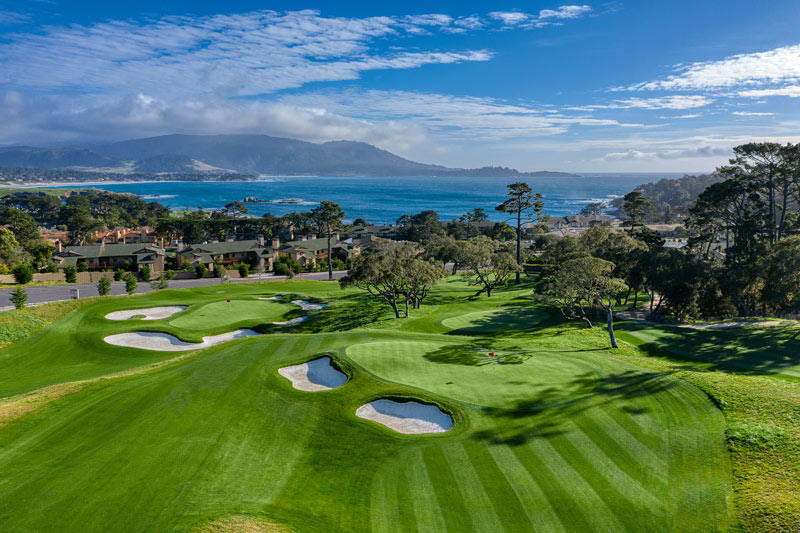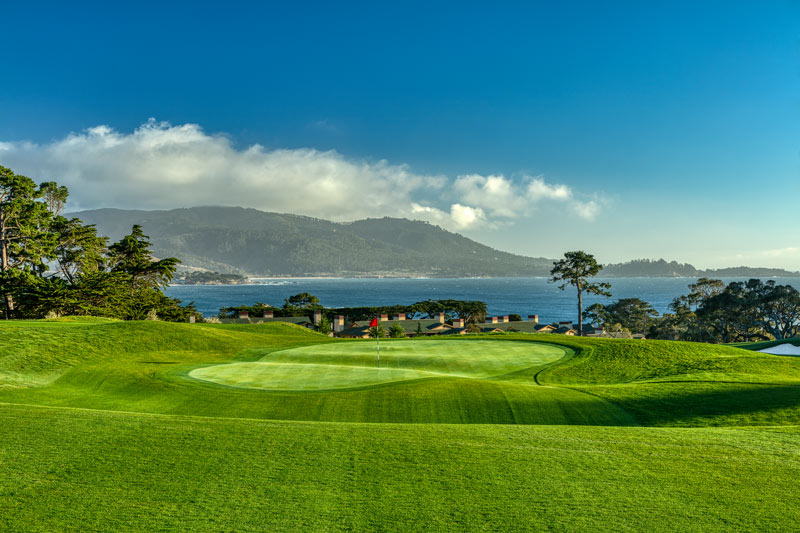
The Hay, which covers roughly 8 acres, gets its name from former Pebble Beach head pro Peter Hay, who designed the original short course on the site in 1957. Photos by Martin Miller
In late 2021, the GCSA of Northern California hosted at chapter event at The Hay, a par-3, 670-yard nine-hole course adjacent to famed Pebble Beach Golf Links. More than 60 people participated. The consensus? From GCSANC members Gavin Dickson, Denis Kerr and Josh Lewis, the short course gets high marks.
“It was like, ‘I’d come back and play this,’” says Dickson, superintendent at Tehama Golf Club in Carmel, Calif., and a 12-year GCSAA member. “It’s maintained well. Great layout. Just cool.”
The Hay, one of the first short courses built in the U.S., was developed by former Pebble Beach head professional Peter Hay in 1957. Hay’s vision was to create a golf course welcoming to all players, regardless of ability.
Fast-forward to April 2021: The Hay reopened for business following a major redesign by Tiger Woods and his TGR Design team.
Fast-forward to today: The Hay will be the topic of conversation at this morning’s Power Hour dubbed “Tiger Woods’ Reimagination of The Hay Short Course at Pebble Beach,” part of the 2022 GCSAA Conference and Trade Show. Those on hand for today’s event — at 10 a.m. on the GCSAA TV stage on the trade show floor — will be Bubba Wright, Pebble Beach Golf Links superintendent; Beau Welling, Woods’ lead architect on the project; and Jason Nau, vice president of builder Frontier Golf. GCSAA CEO Rhett Evans will moderate the panel discussion.
Woods learned how to play on courses like The Hay. At age 8, Woods recorded his first hole-in-one at a short course at Heartwell Golf Course in Long Beach, Calif. “Tiger started playing golf on a short course in Southern California, so he understands from his own journey how important short courses are to introduce new players to the game,” says Bryon Bell, president of TGR Design. “His goal was to make The Hay a fun and welcoming golf experience for players of all abilities.”
As his career skyrocketed, Woods also became synonymous with Pebble Beach. In 2000, he won the AT&T Pebble Beach Pro-Am and ran away with the U.S. Open by a record-shattering 15 strokes. What better place, then, to put his design stamp then at The Hay?
“My feelings about it (The Hay) stem from an affinity for short-course golf. I feel it’s a signature component of the future of golf,” says Josh Lewis, GCSA of Northern California president and a partner with Gradoville and Hertzing Management Group. “It’s an easy walk. Fun, not a grind. And most people won’t lose a golf ball.”

The first green of The Hay is bisected by a Biarritz-style gully.

At 106 yards, the second hole at The Hay, named “Seven,” is an exact replica of the picturesque No. 7 at Pebble Beach Golf Links.
Fewer holes doesn’t mean a substantial reduction in course maintenance work, however, notes Lewis, a 16-year GCSAA member who was the superintendent at Chambers Bay in University Place, Wash., when it hosted the 2015 U.S. Open. Among the challenges on The Hay is whether greens can get enough sunlight to keep the grass growing amid all the traffic. “If it’s 52 (degrees) in July, it’s not exactly ideal for bentgrass with that amazing amount of foot traffic,” Lewis says.
“Amazing” may not do it justice. According to superintendent Bubba Wright, on Feb. 1 The Hay was on track to outpace 50,000 rounds by the time its one-year anniversary rolls around in April (at the start of February, the total was approximately 40,000 rounds). Wright, a four-year GCSAA member, has a dedicated staff of three greenkeepers who maintain the property and are based out of the Pebble Beach Golf Links maintenance facility. The Hay features Pure Distinction bentgrass greens; ryegrass fairways, roughs and tees; and a native blend of predominantly fescue on 2 acres of the course that’s used as a buffer zone between holes.
“It was in great shape when we played — and that job is a tough gig with all the golf they have had,” says Denis Kerr, GCSAA Class A superintendent at Quail Lodge & Golf Club in Carmel, Calif., and a 27-year association member. “Because of the greens, which aren’t large, maintenance is the same, if not more, for them. I was very impressed with what they have done.”
The rich history of Pebble Beach is showcased on each hole of The Hay. For instance, No. 3, “Watson,” is a nod to Tom Watson, who won the 1982 U.S. Open at Pebble Beach, a victory that came after that legendary chip-in for birdie on Sunday. Perhaps the most recognizable hole at The Hay is No. 7, a replica of Pebble Beach Golf Links’ iconic No. 7, one of the most photographed golf holes in the world.
Dickson, who served as an assistant-in-training at Pebble Beach in 2004, sees The Hay as an achievement not only for the facility, but for the entirety of golf.
“When one of the biggest names (Woods) is going to put his name on it, it adds to the legacy of Pebble Beach,” Dickson says. “Whatever can be done to get more people involved in our game is important.”
Howard Richman is GCM’s associate editor.